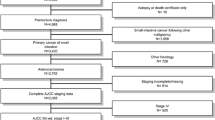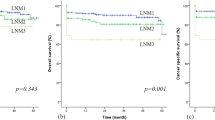Abstract
Background
The number of retrieved lymph nodes in colorectal cancer resection may have an impact on staging and survival. Examination of at least 12 nodes has become a quality measure for adequate surgical practice. To evaluate the impact of the number of retrieved lymph nodes in laparoscopic colorectal surgery for cancer on node-negative patients’ survival.
Methods
Evaluation of our prospective in-hospital collected data of patients that underwent laparoscopic surgery for curable colorectal cancer over a 5-year period. Long-term data were collected from our outpatient’s clinic data and personal contact when necessary.
Results
During a 5-year period since September 2003,173 patients were operated laparoscopically for curable colorectal cancer. Of the 117 patients who were node negative, 85 node-negative patients (72%) had 12 or more evaluated lymph nodes (mean, 18.3 + 2.4), while 32 node-negative patients had less than 12 (mean, 8.3 + 6.2). Patients with fewer than 12 nodes evaluated had significantly more left-sided tumors, while patients with 12 nodes or more had more right-sided tumors. A comparison of 5-year disease free and overall Kaplan–Meier survival curves revealed no statistically significant difference between the two groups.
Conclusions
Evaluation of less than 12 nodes may not necessarily impact patients’ survival in node-negative patients undergoing laparoscopic resection for curable colorectal cancer. A lower number of nodes may be sufficient.



Similar content being viewed by others
References
Jemal A, Siegel R, Ward E, Hao Y, Xu J, Thun MJ (2009) Cancer statistics. CA Cancer J Clin 59:225–249
Samantas E, Dervenis C, Rigatos SK (2007) Adjuvant chemotherapy for colon cancer: evidence on improvement in survival. Dig Dis 25:67–75
Ratto C, Sofo L, Ippoliti M et al (1999) Accurate lymph-node detection in colorectal specimens resected for cancer is of prognostic significance. Dis Colon Rectum 42:143–154
Swanson RS, Compton CC, Stewart AK, Bland KI (2003) The prognosis of T3N0 colon cancer is dependent on the number of lymph nodes examined. Ann Surg Oncol 10:65–71
Nelson H, Petrelli N, Carlin A et al (2001) National Cancer Institute Expert Panel. Guidelines 2000 for colon and rectal cancer surgery. J Natl Cancer Inst 93:583–596
Wong SL, Ji H, Hollenbeck BK, Morris AM, Baser O, Birkmeyer JD (2007) Hospital lymph node examination rates and survival after resection for colon cancer. JAMA 298:2149–2154
Fleshman J, Sargent DJ, Green E et al (2007) The Clinical Outcomes of Surgical Therapy Study Group. Laparoscopic colectomy for cancer is not inferior to open surgery based on 5-year data from the COST Study Group trial. Ann Surg 246:655–662
Jayne DG, Guillou PJ, Thorpe H et al (2007) UK MRC CLASICC Trial Group. Randomized trial of laparoscopic-assisted resection of colorectal carcinoma: 3 year results of the UK MRC CLASICC Trial Group. J Clin Oncol 25:3061–3068
Chang GJ, Rodriguez-Bigas MA, Skibber JM, Moyer VA (2007) Lymph node evaluation and survival after curative resection of colon cancer: systematic review. J Natl Cancer Inst 99:433–441
Priolli DG, Cardinalli IA, Pereira JA, Alfredo CH, Margarido NF, Martinez CA (2009) Metastatic lymph node ratio as an independent prognostic variable in colorectal cancer: study of 113 patients. Tech Coloproctol 13:113–121
Commission on cancer. National Quality Forum-endorsed Commission on cancer measures for quality of cancer care for breast and colorectal cancers. http://www.facs.org/cancer/qualitymeasures.html
Prandi M, Lionetto R, Bini A et al (2002) Prognostic evaluation of stage B colon cancer patients is improved by an adequate lymphadenectomy: results of a secondary analysis of a large scale adjuvant trial. Ann Surg 235:458–463
Ostadi MA, Harnish JL, Stegienko S, Urbach DR (2007) Factors affecting the number of lymph nodes retrieved in colorectal cancer specimens. Surg Endosc 21:2142–2146
Maschuw K, Kress R, Ramaswamy A, Braun I, Langer P, Gerdes B (2006) Short-term preoperative radiotherapy in rectal cancer patients leads to a reduction of the detectable number of lymph nodes in resection specimens. Langenbecks Arch Surg 391:364–368
Baxter NN, Virnig DJ, Rothenberger DA, Morris AM, Jessurun J, Virnig BA (2005) Lymph node evaluation in colorectal cancer patients: a population-based study. J Natl Cancer Inst 97:219–225
Wong SL (2009) Lymph node counts and survival rates after resection for colon and rectal cancer. Gastrointest Cancer Res 3:S33–S35
Bilimoria KY, Bentrem DJ, Stewart AK et al (2008) Lymph node evaluation as a colon cancer quality measure: a national hospital report card. J Natl Cancer Inst 100:1310–1317
Kukreja SS, Esteban-Agusti E, Velasco JM, Hieken TJ (2009) Increased lymph node evaluation with colorectal cancer resection: does it improve detection of stage III disease? Arch Surg 144:612–617
Sarli L, Bader G, Iusco D et al (2005) Number of lymph nodes examined and prognosis of TNM stage II colorectal cancer. Eur J Cancer 41:272–279
Cianchi F, Palomba A, Boddi V et al (2002) Lymph node recovery from colorectal tumor specimens: recommendation for a minimum number of lymph nodes to be examined. World J Surg 26:384–389
Yoshimatsu K, Ishibashi K, Umehara A et al (2005) How many lymph nodes should be examined in Dukes’ B colorectal cancer? Determination on the basis of cumulative survival rate. Hepatogastroenterology 52:1703–1706
Caplin S, Cerottini JP, Bosman FT, Constanda MT, Givel JC (1998) For patients with Dukes’ B (TNM Stage II) colorectal carcinoma, examination of six or fewer lymph nodes is related to poor prognosis. Cancer 83:666–672
Author information
Authors and Affiliations
Corresponding author
Rights and permissions
About this article
Cite this article
Nir, S., Greenberg, R., Shacham-Shmueli, E. et al. Number of retrieved lymph nodes and survival in node-negative patients undergoing laparoscopic colorectal surgery for cancer. Tech Coloproctol 14, 147–152 (2010). https://doi.org/10.1007/s10151-010-0578-z
Received:
Accepted:
Published:
Issue Date:
DOI: https://doi.org/10.1007/s10151-010-0578-z




